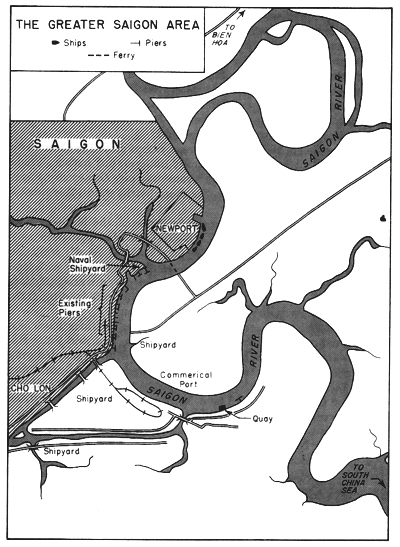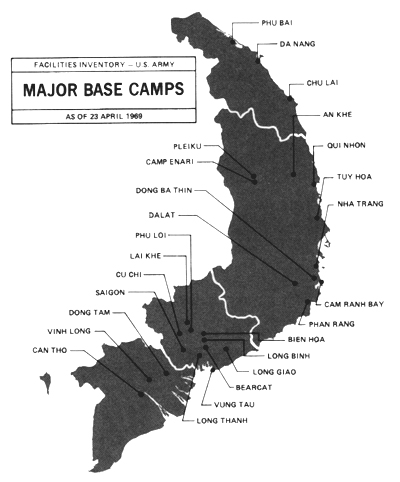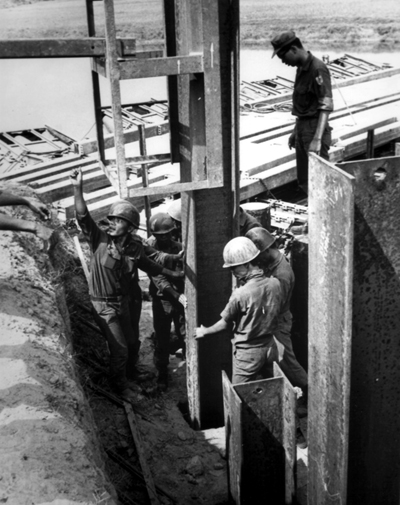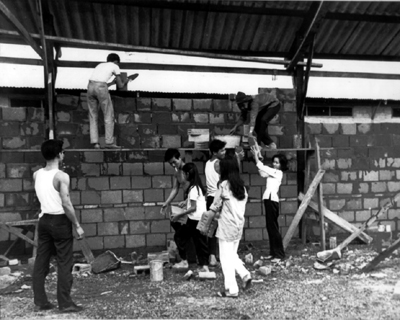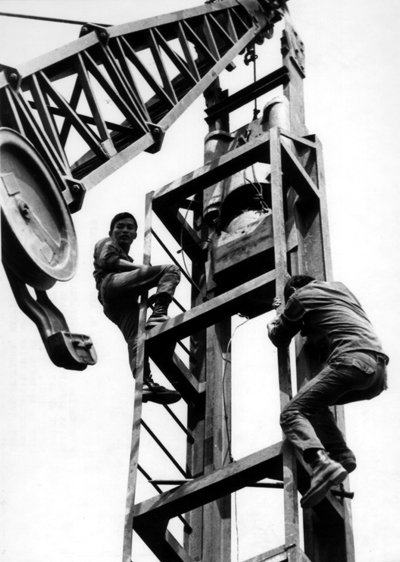- Chapter X:
-
- Lessons and a Legacy
-
- Army base development doctrine before 1965 prescribed that base
development plans be prepared at theater level by component
representatives. Several base development plans for Southeast Asia were
completed. They addressed specific situations with certain assumptions
based on U.S. and Vietnamese responses. While the situation which
materialized after 1965 was much more extensive and the base development
requirements were much greater than those represented in base development
plans, Army planning before 1965 should have identified base requirements
early in the buildup.
-
- In 1965 there was a Pacific Army plan for South Vietnam, but two
significant errors in the operations plan quickly became apparent: the
South Vietnamese Army was not as effective as had been anticipated during
planning, and U.S. deployments had exceeded the plan.
-
- New buildup plans made between April 1965 and January 1966 set the real
scale of base development requirements. Detailed planning was done at the
base or installation level with supervisory control at the service level.
Control at the service level resulted in competition among construction
agencies for limited resources, but management of scarce construction
resources improved when the MACV Directorate of Construction was
established.
-
- Until June 1965 there were few American engineer troops and only a small
contract construction capability in South Vietnam. The buildup had in fact
generated a need for far more engineer construction units than existed in
the active establishment of all the services. Initially the military
construction capability was limited by the decision not to call up the
Reserves or National Guard, which contained the bulk of construction units
in accordance with Department of Defense policy. Major reliance,
therefore, was placed on contractor capability, while the services
accelerated programs to increase the number of construction units in the
active forces. Based on these considerations and the approved force
buildup, a base development plan was devised which consisted of a $1
billion construction program to be accomplished in two years at
approximately a $40 million monthly contract placement rate and executed
- [132]
- under Navy supervision. Allied engineer troops also performed some
construction for their respective forces.
-
- At the beginning of the program there were no set standards except
limitations on living space and the general admonition that facilities
would be minimum and austere. The basic principle in establishing
construction standards was to provide the required facilities for the
expected duration of use as cheaply as possible. Theater standards were
developed to minimize costs and time. These standards were based on three
factors: the mission of the unit for which the facilities were provided,
the permanency of units in a given location, and the philosophy of each
military service. The problem of establishing standards was complicated by
variations in philosophies and the peculiar characteristics of the war.
-
- Although forty-two construction units of battalion strength were
deployed to South Vietnam, the requirements for base development were of
such magnitude that the contractor force supplied a greater construction
capability than the entire military force. This was attributable to the
special equipment and personnel that the contractor could mobilize for
large projects. Equipment like 30-inch pipeline dredges, 30-ton dump
trucks, and 400-ton-per-hour rock-crushers speeded work on big jobs.
-
- Roads were upgraded and surfaced with asphalt paving as a deterrent to
clandestine mining and as a solution to subgrade moisture during the
monsoon rainfall. Land clearing, 100 meters along each side of the right
of way, was a counterinsurgency measure against ambush.
-
- Troop housing was upgraded from tents to tropical wood-frame buildings
because of the rapid deterioration of canvas in a tropical environment.
The static nature and the long duration of operations made it economical
to install better quality more durable utilities and to support services
beyond the temporary nature of the designs in Technical Manual 5-302.
-
- Major airfield runways were first constructed at an expeditionary
standard and then replaced by concrete runways. Although expedient matting
was not durable enough for continuous fighter or heavy transport aircraft
operations, it was sufficient for use on the smaller airfields.
-
- Construction in Southeast Asia was funded by a variety of United States
sources: the Agency for International Development, Military Assistance
Programs, Operations and Maintenance funds, and Military Construction
funds. Control was exercised through tight project allocations with most
of the work being done by military construction funds allocated by
Congress. This type of funding forced extensive preliminary planning and
made approved
- [133]
- projects somewhat cumbersome to change. For major projects approximately
twenty-four months normally elapsed between the development of
requirements and final construction. Some of this delay can be attributed
to the procurement of materials and some of the administrative
requirements that all funds for construction be on hand before the start
of construction. Stringent control made changes difficult and did affect
over-all operations to some degree because once the sites had been
determined for ports and airfields their requirement was subject to change
in light of ongoing operations.
-
- Costs for construction in South Vietnam were approximately two and a
half times greater than for similar construction in the United States.
This is attributable to the 12,000-mile supply line, a premium wage rate
for U.S. nationals, the urgency placed on all projects, and the crash
nature of the program. As the intensity of hostilities diminishes, many
things can be built of local materials by local labor at far less cost.
-
- Contractor costs included an extensive support force (that is, direct
labor was 15 percent of the labor .force in South Vietnam compared to 60
percent on construction projects in the United States). While tabulated
troop construction costs included only the material, the overhead costs
were very high because of the combat training needed and the special
military support costs.
-
- The construction done in 1965-68 in South Vietnam enabled the United
States to deploy and operate a modern 500,000-man military force in an
underdeveloped area. The ground combat force of 165,000 men was able to
combat an enemy force effectively from an adequate facility base which
permitted U.S. and allied forces to concentrate and operate when and where
they wished. Most construction was temporary; the more durable
construction will become economic assets for South Vietnam. (Map 12 and
Table 5)
-
- The Army's base development activities in South Vietnam during 1965-68
have been reviewed in a series of assessments: "Observations on the
Construction Program Vietnam" by Brigadier General Daniel A. Raymond
(June 1967); the Chief of Engineers sponsored Seeman Board (February
1968); the joint Chiefs of Staff sponsored Special Military Construction
Study Group (October 1968); and the Office, Secretary of Defense's Joint
Logistic Review Board (September 1970). Several major problem areas and
corrective actions have been revealed and suggested in these assessments.
-
- The wide disparity of construction standards between the services in
Vietnam was particularly evident in cantonment construction. Air Force
planners contended that a $100 million base was not a transient facility
and wanted more for their money in durable
- [134]
- MAP 12 - MAJOR BASE CAMPS
-
- construction. They felt that pilots and electronics technicians lost
efficiency when forced to live like combat troops. This caused
dissatisfaction between the troops of different services living in the same
general area.
-
- The Joint Chiefs of Staff took up the standards of construction problem in
November 1969, but left the decision to the President. In June 1970, the
joint Chiefs of Staff Construction Board for Con-
- [135]
-
| Installation |
Cantonement
Capability |
Admin. Space Square
Feet
|
Storage Space S |
Maint Space Square Feet |
| Based On Housing |
Based On W.B.Sewage @ 80
GPD/MAN (Total) |
Based On Water Supply @ 100
GPD/MAN (Total) |
| Officers |
EM |
Covered S.F. |
Open S.Y. |
| Phu Bai |
754 |
5,800 |
1,000 |
1,700 |
93,784 |
127,983 |
9,777 |
48,532 |
| Da Nang |
671 |
4,865 |
1,150 |
1,790 |
106,500 |
21,634 |
89,617 |
114,425 |
| Chu Lai |
1,595 |
10,337 |
0 |
4,520 |
76,615 |
101,881 |
56,587 |
262,949 |
| Pleiku |
611 |
9,521 |
0 |
10,000 |
119,497 |
112,669 |
5,916 |
100,547 |
| Camp Enari |
1,023 |
9,223 |
0 |
5,680 |
300,420 |
85,600 |
58,200 |
218,898 |
| An Khe |
1,950 |
12,000 |
0 |
4,500 |
259,730 |
225,492 |
107,761 |
188,942 |
| Qui Nhon |
1,870 |
20,980 |
2,065 |
3,070 |
519,200 |
1,050,499 |
359,242 |
499,128 |
| Tuy Hoa |
1,002 |
6,765 |
750 |
5,130 |
116,345 |
88,438 |
233,550 |
92,063 |
| Nha Trang |
438 |
7,958 |
5,080 |
7, 340 |
275,407 |
306,605 |
51,840 |
154,541 |
| Dong Ba Thin |
563 |
2,430 |
0 |
2,650 |
38,192 |
7,600 |
0 |
25,220 |
| Dalat |
7 |
579 |
80 |
1, 000 |
3,821 |
17,767 |
373 |
1,760 |
| Cam Ranh Bay |
1,479 |
17,173 |
0 |
10,000 |
440,900 |
873,425 |
622,844 |
377,795 |
| Phan Rang |
220 |
4,487 |
0 |
720 |
48,119 |
48,075 |
230 |
11,176 |
| Lai Khe |
532 |
3,706 |
0 |
700 |
72,326 |
17,038 |
105,350 |
26,216 |
| Phu Loi |
932 |
5,721 |
0 |
12,500 |
81,032 |
36,716 |
149,055 |
481,013 |
| Cu Chi |
1,512 |
12,616 |
0 |
4,500 |
207,261 |
125,036 |
91,560 |
191,800 |
| Bien Hoa |
815 |
8,407 |
6,035 |
22,680 |
134,597 |
91,972 |
3,333 |
136,353 |
| Long Binh |
5,855 |
36,987 |
16,250 |
25,530 |
1,085,544 |
992,655 |
1,269,901 |
917,734 |
| Black Horse (Long Giao) |
307 |
4,537 |
0 |
1,800 |
79,320 |
30,302 |
5,333 |
6,824 |
| Bearcat |
972 |
7,615 |
0 |
13,200 |
125,132 |
60,978 |
64,207 |
117,778 |
| Macv- Saigon-T.S.N |
10,768 |
23,288 |
250 |
14,700 |
1,143,452 |
1,453,945 |
64,813 |
221,155 |
| Saigon Ports |
218 |
1,379 |
3,875 |
2,470 |
163,582 |
945,499 |
365,231 |
61,093 |
| Long Thanh North |
189 |
933 |
0 |
5,400 |
21,808 |
28,880 |
27,710 |
70,050 |
| Vung Tau |
294 |
8,182 |
2,625 |
4,140 |
136,390 |
267,757 |
135,068 |
331,035 |
| Dong Tam |
1,193 |
10,995 |
0 |
6,480 |
160,210 |
89,184 |
11,247 |
212,266 |
| Vinh Long |
365 |
2,435 |
188 |
2,400 |
11,544 |
25,951 |
0 |
46,582 |
| Can Tho |
131 |
1,915 |
337 |
5,120 |
41,419 |
32,782 |
28,050 |
48,643 |
- [136]
- tingency Operations made minor modifications to the 1966 standards and suggested the following standards for construction and base
development in support of contingency operations:
-
- Field: Cantonments for forces whose activities are such that they may be
characterized as essentially transient.
- Intermediate: Cantonments for forces subject to move at infrequent
intervals. Anticipated duration of occupancy: 24-48 months.
- Temporary: Cantonments for forces not expected to move in the
foreseeable future.
-
- Experience in Vietnam has shown that a Director of Construction should
operate directly under the command of and as part of the staff of the
joint commander in the combat area to ensure effective and responsive
co-ordination with operations and logistic support. A Director of
Construction provides the commander of a joint force with the means of
exercising control and direction over construction. The Joint Logistics
Review Board suggested that contingency planning set forth the appropriate
composition and role of a construction directorate on the staff of the
joint field commander.
-
- The board has also made several recommendations pertaining to funding
for construction in support of contingency operations, but the funding
problem persists pending revision of Department of Defense instructions.
While not as detailed as construction programs, base development planning
can provide the data necessary to keep construction costs within limits
set by funding procedures.
-
- The board further noted that there were no country-to-country agreements
or draft agreements in support of contingency plans for Vietnam that could
have expedited real-estate acquisition. Also, there were too few trained
real estate teams available to meet the needs of the many widely separated
bases and operational areas requiring property for the expanding war.
-
- The Joint Chiefs have developed procedural plans to resolve many of our
real-estate problems. Base development plans now identify real-estate
requirements, existing base rights, and any additional rights that are
necessary. Such plans can provide a basis for the start of negotiations
for real-estate agreements in areas for which contingency plans have been
prepared. The Army has recently organized real estate teams with the
capability of deploying into a contingency operation area and augmenting
and expediting measures to obtain real estate for American military
operations.
-
- Investigations into planning, procurement, and shipping to provide
material for construction in Southeast Asia identified several weaknesses
in the Engineer Functional Components System. Prob-
- [137]
- lems resulted from the differences between standard design and actual
requirements and the inability to use the system to initiate procurement
and shipping actions. Construction forces and large organizations can
achieve considerable savings by planning around local resources and
conditions. Designs should be flexible enough to use substitute materials
when time or money can be saved. Direct delivery can help maximize
savings. In other words, the system should be flexible and allow for
special requirements. The inadequacy of base development plans during the
Vietnam buildup, for example, has produced new interest in the functional
components system. Efforts are under way to update and refine the system,
which is now called the Army Facilities Component System, and to make
better use of the Army supply system.
-
- As a result of the Special Military Construction Studies Group
recommendations in October 1968, the joint Chiefs established the joint
Staff/Services Construction Board for Contingency Operations. To date,
papers have been distributed on suggested standards of construction for
cantonments and planning factors for many Department of Defense
categories.
-
- Since mid-1968, the Army staff has provided base development planning
assistance to the commanders of subordinate Army commands. Eight base
plans in support of selected contingency operations have been drafted.
Others are being prepared some of which will also serve as joint base
development plans. The drafts provide the information and detail required
by the joint Chiefs directive and use automatic data processing to produce
the output in hard copy or card decks. Increased use of data processing
over the past few years has significantly reduced planning preparation
time. Pacific Command Base Development System has recently been improved
and simplified to eliminate nonessential data and reduce the work required
in developing plans. U.S. Army, Pacific, and the other service component
commands assisted in developing these improvements. To reduce further the
preparation time and effort of draft base plans, a computer system will
soon be available which will perform a major portion of the facilities
identification and work calculations.
-
- A proposal is being considered to establish in the Army staff a central
planning office for base development. Such an office would support the
Army by drafting component and joint base development plans and enhance
planning capability by pooling experienced planners with an adequate
computer hardware system. The planning office would provide a useful point
for liaison with Army and other joint staffs.
-
- The Army Base Development Board (BDB) is sponsored by the
- [138]
- Deputy Chief of Staff for Logistics and was established as a continuing
committee on 14 October 1970. Its mission is to evaluate the concepts,
management systems, and supporting mat6riel systems for base development
within the Department of the Army. It will determine their adequacy and
initiate such measures as necessary to establish staff responsibilities
and ensure that Army base development support in future contingency
operations is both effective and responsive. This board will maintain the
momentum and initiatives started by the joint staff.
-
- Since the Vietnamese will be responsible for the care and maintenance of
base facilities and lines of communications, it is important that skilled
people be available. For several years U.S. Army engineers have informally
given Vietnamese engineer units technical assistance and training to
enhance their capability. In October 1968 Major General David S. Parker,
then USARV Engineer and Commanding General, Engineer Troops, Vietnam,
formally initiated a program of affiliation with Vietnamese engineer
units. Through liaison provided by the MACV Engineer Advisor, U.S.
engineer units work with their Vietnamese counterparts to complete their
projects jointly. Vietnamese engineer troops have been learning the
American way of doing things.
-
- In addition to training Vietnamese military personnel, both American
military organizations and civilian contractors have hired and trained
many Vietnamese civilians to work on construction and maintenance
projects. Certainly, the development of a Vietnamese construction
capability will probably become the most enduring economic consequence of
the base construction program.
-
- In Vietnam, as in other underdeveloped countries, skilled labor has been
in short supply. The future progress of these nations depends to a marked
degree on the presence of an adequate labor force. At the beginning of the
American buildup in 1965, nearly three-quarters of the Vietnamese labor
force was engaged in agriculture and related occupations. There was a
severe shortage of skilled workers. While some were skilled in basic
carpentry, masonry, sheet-metal handling, and electrical work, few were
familiar with modern construction methods or equipment, and many had been
inducted into the armed forces.
-
- This situation was caused in part by an educational philosophy which
honors the diploma more than the skills it is supposed to represent. In
Vietnam manually skilled workers have been denied the status and earnings
commensurate with the value of their skills to society. As taught in the
Vietnamese schools, manual and vocational training prepare the student for
semiprofessional occupations rather than for the actual building trades.
- [139]
- CORPORAL MUNG, 103d Engr. Bn., ARM, directs his construction crew in
pile driving for a new bridge.
-
- The arrival of American military and contractor organizations created an
overwhelming demand for construction workers. There not being enough in
Vietnam, some workers were recruited from America and from the Philippine
Islands, Taiwan, and Korea. So acute was the shortage of trained workers
that contractors had to
- [140]
- hire unskilled local nationals and show them what tools to use and how to use them.
-
- In the earliest stages of wartime vocational training, workers received
on-the-job training to satisfy the immediate needs of a particular
employer. The unskilled were assigned as helpers to pick up whatever they
could by observation and practice. Gradually, as they proved they could
handle the equipment, they were left more and more on their own. Manual
training later advanced from on the-job training to formal programs with
full-time "foremen-operators" as instructors. Trainees then
learned how to operate different machines and fully to understand
equipment capabilities.
-
- At its peak in July 1966, RMK-BRJ employed some 50,000 Vietnamese at
fifty locations. Because of the labor turnover caused by the draft or by
the reluctance of the Vietnamese to relocate on jobs farther from their
homes, RMK by 1970 had cumulatively hired more than 200,000 persons. Among
those trained at contractor run schools were accountants, clerk-typists,
engineer-draftsmen, auto mechanics and painters, drivers, electricians,
machinists, heavy equipment operators, refrigeration and air-conditioning
maintenance men, and welders. Besides acquiring technical skills, all
students also studied English.
-
- Between 1965 and 1970 Pacific Architects and Engineers trained some
28,000 Vietnamese in various facets of facilities engineering in the
operation and maintenance of boiler plants, water plants, kitchen
equipment, generators, and refrigeration and air-conditioning equipment-as
well as firefighters, engineer-draftsmen, auto mechanics, electricians,
heavy-equipment operators, and stock clerks. In 1966 PA&E established
a training department in Saigon for both formal and on-the-job training.
One of its most successful projects has been the training of women to work
as welders, carpenters, generator operators, crane operators, and vehicle
operators.
-
- In addition, engineer units of the U.S. Army, Navy, and Air Force have
trained thousands of other Vietnamese civilians. During October 1967 the
U.S. Army Engineer Command, Vietnam, employed over 8,500 Vietnamese, many
of whom acquired new skills and insights through this experience.
-
- As the Joint Development Group has pointed out, the improved skill base
will strengthen Vietnam's postwar economy. Those ex-servicemen and
civilians who have worked in war-related construction will be able to
transfer readily to peacetime reconstruction. It is expected that most
will find suitable employment in private and public sectors. Civil
projects will include programs for the repair and maintenance of highways,
bridges, and railroads, and projects for water control, irrigation, and
land reclamation needed
- [141]
- STUDENT VOLUNTEERS help construct a dormitory for roar orphans
at the Buddhist Institute, Saigon.
-
- for agricultural expansion. Thus these people will form a base of
skilled labor in postwar Vietnam and will make a significant contribution
to the development of their homeland.
-
- General Westmoreland had established a priority system for the turnover
of U.S. developed property. Although all facilities and bases will be
given to the Vietnamese as part of the Vietnamization process, a claim
system allows other U.S. forces to have a last chance at property being
disposed of. The order runs thus: U.S. forces, Vietnamese armed forces,
U.S. forces outside Vietnam, and other U.S. agencies. Between 11 September
1969 and 15 September 1970, thirty-nine installations were transferred to
the Vietnamese Army. Total acquisition cost of these facilities was
$43,428,000. Among the more valuable were 4 divisional bases, costing
$23,950,000; 2 minor ports, costing $7,544,000; 2 compounds, costing
$2,556,000; and 2 cantonments, costing $2,547,000.
-
- In some respects the task of building a military base is comparable to
that of building a town. Perhaps the major difference is that bases are
planned to serve specific ends, while towns are usually unplanned and grow
on the basis of expediency rather than purpose. Typical military bases
contain cantonments, storage facilities, roads, electric power plants,
communications centers, water
- [142]
- supply and sewage systems, and provisions for security. Bases may also
include airfields, ports, and fuel storage and distribution facilities. We
can look back now to some of the outstanding base facilities and related
engineering left to our Vietnamese allies.
-
- Initially the port of Saigon provided the only unloading facilities for
oceangoing vessels. Its six deep-draft berths were altogether inadequate
for handling regular commercial shipping and the hundreds of ships
bringing military cargo from America. The result was an enlarging of port
facilities fivefold.
-
- In the spring of 1965 Army engineer troops moved to Cam Ranh Bay, an
excellent natural but a wholly undeveloped harbor. There they installed a
DeLong pier and a causeway pier that enabled four ships to unload
simultaneously. Six more berths were subsequently constructed in this
harbor.
-
- To handle military cargo in the Saigon area, the Newport port facilities
were constructed by RMK-BRJ on what had been rice paddy land two miles
north of Saigon. (Map 13) As silt from the river bottom was unsuitable for
fill, great quantities of rock and sand were brought in by barge and
truck. Newport can accommodate simultaneously 4 oceangoing vessels, 4
shallow-draft landing craft, and 7 barges. The cost was nearly $25
million.
-
- Deepwater berths and appurtenant coastal facilities have also been
constructed at Da Nang, Qui Nhon, Vung Tau, and Vung Ro.
-
- Vietnam has been the scene of one of the world's largest dredging
operations. Since 1966, fourteen or more dredges have been doing harbor
and land-fill work. They have cleared and deepened harbors, rivers, and
canals; stockpiled sand for road and base ca up construction; and
reclaimed land for military, industrial, and housing sites. Without
continuing dredging operations the accumulation of silt will, however,
close the harbors and inland waterways to navigation.
-
- Eight airfields designed to accommodate large jet aircraft were
constructed at Da Nang, Chu Lai, Phu Cat, Tuy Hoa, Cam Ranh Bay, Phan
Rang, Bien Hoa, and Tan Son Nhut. These are huge installations with
10,000-foot runways and the whole range of appurtenant facilities,
including administrative buildings, hospitals, hangars, repair shops,
warehouses, barracks, and mess halls. In November 1967, of ninety other
airfields using expedient surfacing materials, eleven were operational for
jets and sixty-two for C-180 medium cargo aircraft.
-
- A massive well-drilling program has accompanied the buildup of American
forces in Vietnam. Although USAID had sponsored well-drilling in Vietnam
since 1957, MACV had to develop its own water supply for its bases. Major
work was done under contract to the Navy's OICC. Between July 1966 and
September 1967, con-
- [143]
-
- tractors drilled 233 successful wells and 48 test holes at twenty-five
sites. These wells had an average depth of 170 feet and an average test
yield of 96 gallons per minute. Additional wells have been drilled by
Engineer Well Drilling detachments. As of 1 December 1967, 100 wells had
been developed and 14 more were under way.
- [144]
- Besides wells now in production, the records of the well-drilling
program will be valuable to geologists and engineers charged in peacetime
with the responsibility for developing Vietnam's water resources.
-
- "Pentagon East," as the MACV command post has been called, was
constructed near Tan Son Nhut Airport. Its network of two-story prefabricated buildings provides air-conditioned working space for 4,000
men. In addition to cantonments and utilities, it includes mortar
shelters, security fences, and guard towers. The headquarters complex for
USARV was constructed at Long Binh, -sixteen miles from Saigon. It
occupies twenty-five square miles and houses 50,000 soldiers at a cost of
more than $100 million.
-
- A mere cataloging of works performed by engineer troops would more than
fill the pages of this study. Among the major projects under construction
by engineer troops at the beginning of 1968the last year of major
construction-were fifteen cantonments large enough to accommodate from
4,000 to more than 17,000 men.
-
- The Road Restoration Program was the largest project of its kind ever
undertaken by the U.S. military in a foreign country. It was started under
USAID totally and transferred to MACV control in September of 1968.
Priorities had been jointly established by military and civil authorities.
The goal was to construct and upgrade 4,800 kilometers of national and
interprovincial highways, replacing obsolete French standards with those
of American highway engineers. When completed the system of two-lane
all-weather roads will pass through the delta, Saigon, northward along the
coast, and into the Central Highlands. Standard bridge designs and
standard highway and bridge marking and. numbering procedures have been
adopted.
-
- This vast highway restoration project will strengthen the unity and the
economy of Vietnam. Lacking the air mobility of USARV, the Vietnamese will
utilize the roads to deploy swiftly toward Communist-menaced communities.
The roads will end the isolation of rural areas and open them to trade.
-
- Since 1967 an independent research agency, the joint Development Group,
has been studying the economic prospects of postwar Vietnam. Many of the
facilities discussed in this chapter have also been examined by the group
from a economic point of view. The group notes that the ports, airfields,
highways, and railroads built or repaired under military auspices will
amply satisfy the needs of an expanding national development.
-
- The new and improved seaports should greatly improve coastal and
international shipping and travel. The airfields have already Wade Vietnam
an important part of the international air network.
- [145]
- NEWLY TRAINED ARMY Engineers return to the task of nation building.
-
- The highway development program is multiplying contacts between
villagers and townspeople and enables both to transport goods and
commodities farther, faster, cheaper, and safer. Peasants are rebuilding
homes and reworking fields that they had abandoned under
- [146]
- Communist pressure before the roads were built. New trading centers
accompany the restoration of the roads.
-
- Clean, potable water should reduce the incidence of infectious
debilitating diseases. Improved water supply should lower the rates in
infant mortality and adult chronic illness.
-
- When peace comes, new uses will be found for the military building
complexes. Some of the buildings may be converted into schools, housing,
factories, warehouses, shops, or offices.
-
- The ravages of rot, jungle, and weather have left only memories of the
once-mighty World War II bases of the South Pacific. The pessimist may
predict that such will be the fate of the bases in Vietnam. The future,
however, is likely to prove that the Vietnamese are too resourceful not to
find applications for many of the facilities left behind to them.
- [147]
- page created 15 December 2001
Previous Chapter
Return to the Table of Contents
